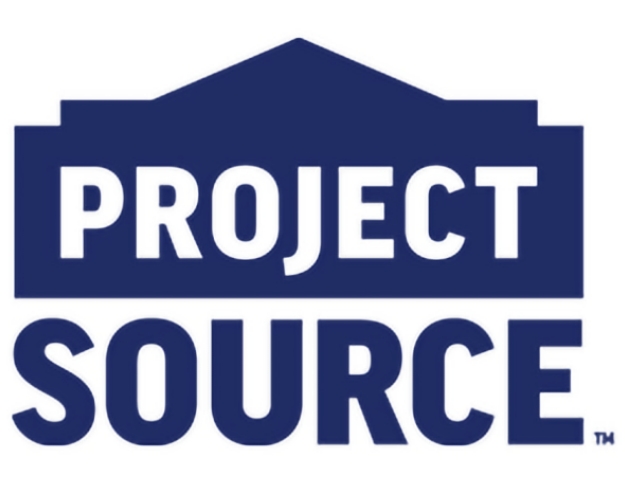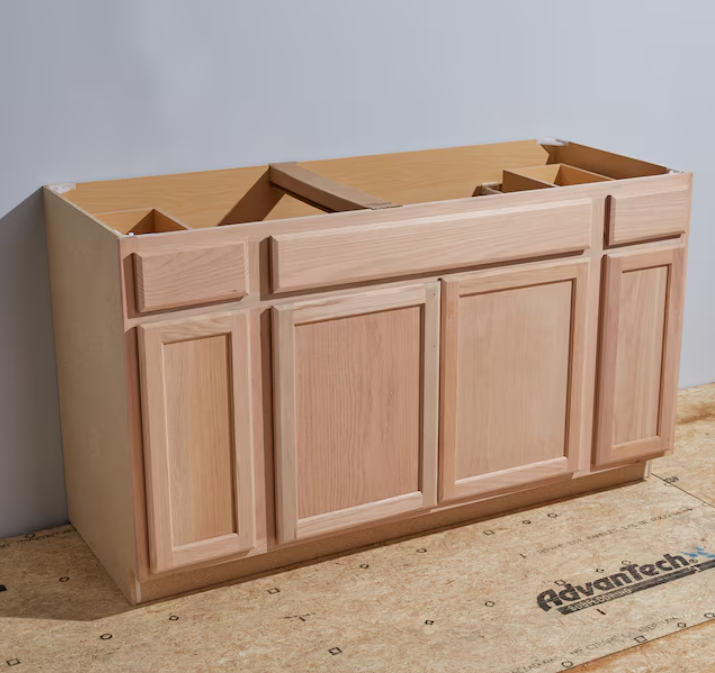
Project Source Oak Brook 60-in W x 35-in H x 23.75-in D Natural Unfinished Oak 2 -Drawers Sink Base Fully assembled Cabinet (Flat Panel Square)
- Unfinished cabinet can be painted, stained or left as is to coordinate with your decor
- Solid wood face frame provides stability and complements a variety of kitchen styles
- 2 doors provide access to convenient under-sink storage for dish soap and cleaning products
- Transitional flat panel door complements a variety of design styles
- Fully assembled for hassle-free installation
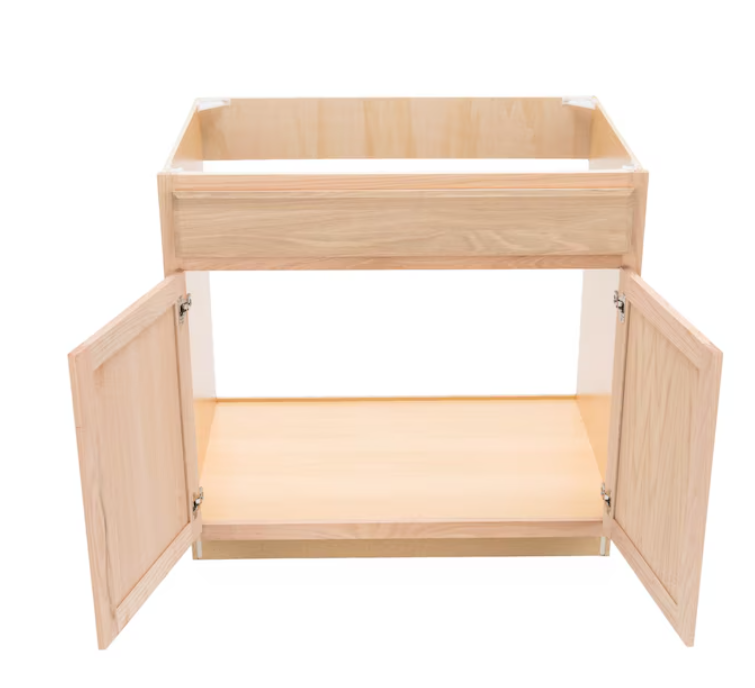
Project Source Oak Brook 36-in W x 35-in H x 23.75-in D Natural Unfinished Oak Sink Base Fully assembled Cabinet (Flat Panel Square)
- Unfinished cabinet can be painted, stained or left as is to coordinate with your decor
- Transitional flat panel door complements a variety of design styles
- Solid wood face frame provides stability and complements a variety of kitchen styles
- 2 doors provide access to convenient under-sink storage for dish soap and cleaning products
- Fully assembled for hassle-free installation
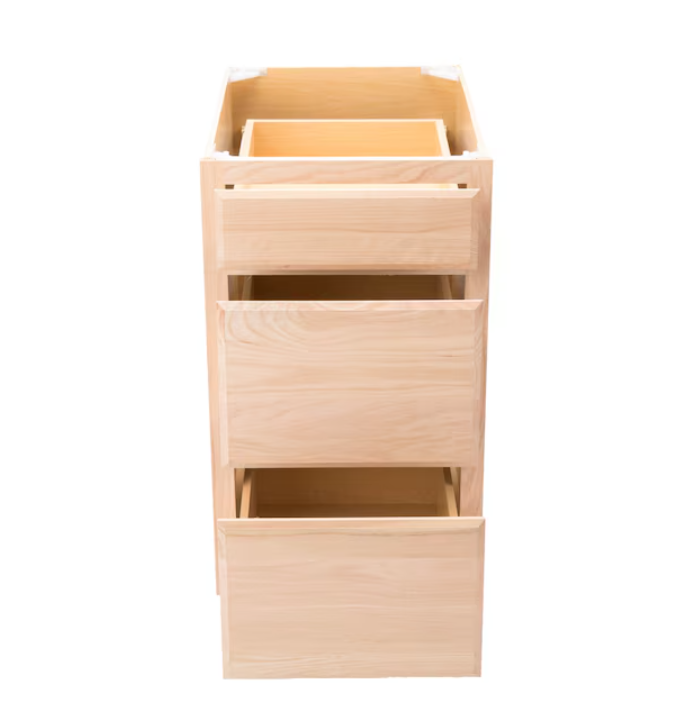
Project Source Oak Brook 18-in W x 35-in H x 23.75-in D Natural Unfinished Oak 3 -Drawers Drawer Base Fully assembled Cabinet (Flat Panel
- Unfinished cabinet can be painted, stained or left as is to coordinate with your decor
- Transitional flat panel door complements a variety of design styles
- Solid wood face frame provides stability and complements a variety of kitchen styles
- 3 drawers provide convenient storage for kitchenware
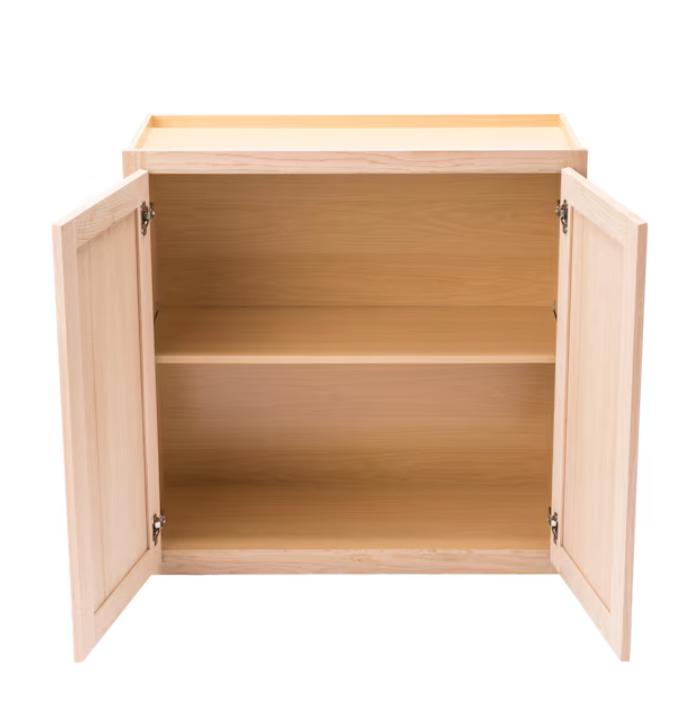
Project Source Oak Brook 30-in W x 30-in H x 12-in D Natural Unfinished Oak Wall Fully assembled Cabinet (Flat Panel Square)
- Unfinished cabinet can be painted, stained or left as is to coordinate with your decor
- Transitional flat panel door complements a variety of design styles
- Solid wood face frame provides stability and complements a variety of kitchen styles
- 1 shelf provides convenient storage for dinnerware and dry goods
- Fully assembled for hassle-free installation
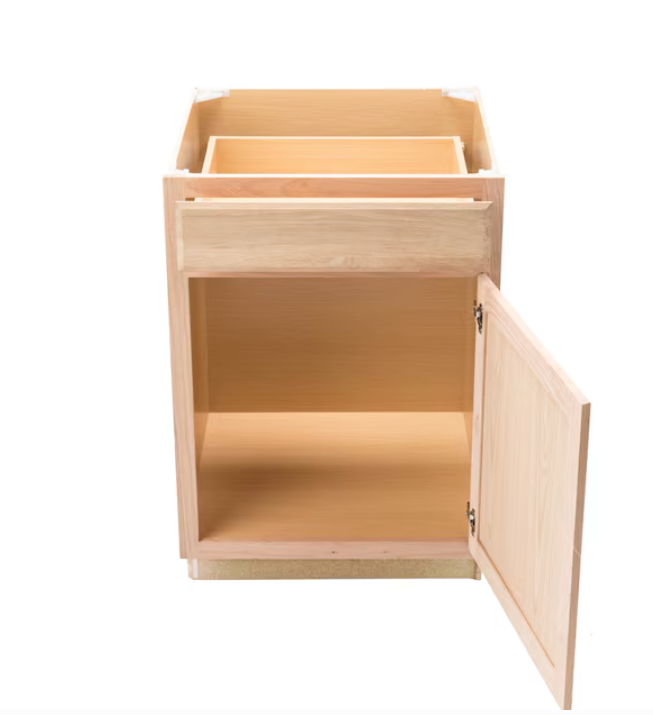
Project Source Oak Brook 24-in W x 35-in H x 23.75-in D Natural Unfinished Oak Base Fully assembled Cabinet (Flat Panel Square)
- Unfinished cabinet can be painted, stained or left as is to coordinate with your decor
- Transitional flat panel door complements a variety of design styles
- Solid wood face frame provides stability and complements a variety of kitchen styles
- 1 drawer provides convenient storage for items like utensils and cookware
- Fully assembled for hassle-free installation
Affordable Quality Meets Practical Design: Everything You Need to Know About This Popular Cabinet Line
If you’ve been browsing the aisles of home improvement stores lately or searching online for budget-friendly cabinet options, you’ve likely encountered the Project Source brand. As someone who has not only installed these cabinets in multiple homes but also researched them extensively, I’m excited to share this comprehensive guide that answers all your burning questions about this popular cabinet line.
When I first discovered Project Source cabinets during my kitchen renovation three years ago, I was immediately drawn to their attractive price point. But like many homeowners, I wondered: Would budget-friendly cabinets hold up over time? Were they truly worth the investment? After living with them through cooking marathons, holiday gatherings, and everyday use, I’ve gained valuable insights that can help you make an informed decision for your own home.
What Are Project Source Cabinets?
Project Source cabinets are a line of affordable, ready-to-assemble cabinetry designed for homeowners seeking budget-friendly options without sacrificing quality and style. Primarily sold through Lowe’s home improvement stores, these cabinets have become increasingly popular among DIY enthusiasts, first-time homebuyers, rental property owners, and anyone looking to renovate on a tight budget.
What sets Project Source apart from other budget cabinet lines is their balance of affordability, decent quality, and surprisingly versatile style options. They’re positioned as an entry-level cabinet solution that doesn’t immediately scream “budget” once installed. While they may not feature the solid wood construction or custom details of high-end cabinetry, they offer a respectable alternative that can transform a space without draining your renovation fund.
The Project Source line typically includes base cabinets, wall cabinets, pantry cabinets, vanities, and various specialty cabinets like corner units and sink bases. This comprehensive range allows homeowners to create cohesive kitchen layouts, bathroom vanities, laundry rooms, and even garage storage systems using products from the same line.
Materials Used in Project Source Cabinets
Understanding what your cabinets are made of helps set appropriate expectations for their performance and longevity. Project Source cabinets are constructed primarily from engineered wood products, specifically medium-density fiberboard (MDF) and particleboard with laminate or thermofoil finishes.
The cabinet boxes feature particleboard sides with a melamine coating that provides moisture resistance and a clean interior finish. Door and drawer fronts are typically MDF with either a vinyl thermofoil coating or laminate finish, depending on the specific style. These materials allow for the cabinets’ affordable price point while still providing reasonable durability for everyday use.
Hardware components include metal drawer slides, hinges, and shelf pins. While not the premium soft-close hardware found in higher-end cabinetry, the included hardware performs adequately for typical household use. Many homeowners choose to upgrade the included handles and knobs with aftermarket options for a more customized look.
It’s worth noting that while engineered wood products are more susceptible to moisture damage than solid wood, proper care and installation in appropriate environments can significantly extend their lifespan. These materials also offer benefits like resistance to warping and dimensional stability across different seasons and humidity levels.
Durability: What to Expect
When investing in any cabinetry, even budget-friendly options, durability concerns are natural. Project Source cabinets offer what I’d describe as “appropriate durability” for their price point. With proper installation and reasonable care, these cabinets can provide 7-10 years of satisfactory service in moderate-use environments.
The thermofoil and laminate finishes resist staining and are relatively easy to clean, giving them an advantage over some painted finishes that might chip more easily. The particleboard construction, while not as robust as plywood or solid wood, performs adequately when cabinets are correctly installed and not overloaded.
Common durability concerns include:
- Susceptibility to water damage if exposed to prolonged moisture
- Potential for particleboard sagging on wide shelves when heavily loaded
- Possible delamination of edge banding over time, particularly in high-humidity environments
- Hardware that may loosen with frequent use
To maximize durability, many homeowners take preventative measures like applying silicone caulk along sink-adjacent edges, installing moisture barriers under sink cabinets, and being mindful of weight distribution on shelves. These simple steps can significantly extend cabinet life.
A neighbor of mine installed Project Source cabinets in her rental property five years ago, and they’ve held up remarkably well through multiple tenants. Her secret? Proper installation, careful sealing around water-prone areas, and prompt attention to any minor issues before they become major problems.
Available Colors and Styles
Despite their budget classification, Project Source cabinets offer a surprising range of color and style options to coordinate with various design aesthetics. The most common finishes include:
- White (the perennial bestseller)
- Off-white/cream
- Gray (in various shades from light to charcoal)
- Brown/wood-look finishes (typically in oak, cherry, or espresso tones)
- Black (for more contemporary designs)
Style options typically include:
- Shaker-style doors (the most popular choice for their classic, versatile appeal)
- Flat-panel doors (for contemporary and minimalist designs)
- Raised-panel doors (offering a more traditional look)
- Slab drawer fronts (streamlined and easy to clean)
While the color and style selection isn’t as extensive as semi-custom or custom cabinet lines, Project Source offers enough variety to coordinate with most common design schemes. The neutral color palette particularly lends itself to personalization through hardware, backsplash, and countertop choices.
Many homeowners appreciate that the most popular finishes—white and gray—align perfectly with current design trends, allowing for an updated look without the premium price tag. The white cabinets, in particular, create a bright, spacious feeling even in smaller kitchens and provide a neutral backdrop for colorful accessories and appliances.
Cost Considerations: What to Budget
One of the most compelling aspects of Project Source cabinets is their affordability. For many homeowners working with tight renovation budgets, these cabinets make kitchen and bathroom updates possible when more expensive options would be out of reach.
Price points vary based on cabinet size and configuration, but generally fall within these ranges:
- Base cabinets: $80-$200 per cabinet
- Wall cabinets: $60-$150 per cabinet
- Pantry/utility cabinets: $200-$400 per cabinet
- Bathroom vanities: $100-$300 depending on size
For perspective, a small 10’×10′ kitchen might require approximately 12-15 cabinets total. With Project Source, this could cost between $1,200-$2,500 for all cabinetry, compared to $5,000-$15,000 for semi-custom options and $15,000-$30,000+ for custom cabinetry.
Beyond the cabinet costs, budget-conscious homeowners should consider:
- Installation costs (if not DIY)
- Hardware upgrades (if desired)
- Filler pieces and trim
- Countertops (not included)
- Potential delivery fees
The real value proposition comes from comparing the total installed cost to the visual impact. Many visitors to homes with Project Source cabinets are surprised to learn they’re a budget option, especially when paired with thoughtful countertop selections and contemporary hardware.
Where to Purchase Project Source Cabinets
Project Source is a house brand primarily available through Lowe’s home improvement stores. This exclusive distribution channel offers both advantages and limitations for consumers.
The cabinets can be purchased through several channels:
- In-store at Lowe’s locations nationwide
- Online through Lowe’s website
- Through Lowe’s kitchen design services
The in-store option allows customers to see display models, open and close drawers, and get a tangible sense of the construction quality before purchasing. Most stores have sample doors available to take home and compare within your space.
Online purchasing offers convenience but lacks the tactile experience of seeing the cabinets in person. However, the detailed measurements, specifications, and customer reviews available online help inform purchasing decisions. Many homeowners use a hybrid approach—viewing cabinets in-store but placing orders online for home delivery.
Lowe’s kitchen design service provides another option, where store designers can create a complete layout using Project Source cabinets based on your measurements or their in-home measuring service. This service often includes 3D renderings of the proposed design and can be helpful for visualizing the finished space.
Availability can sometimes be an issue, with popular sizes and styles occasionally being out of stock. Planning ahead and ordering well before your intended installation date can help mitigate potential delays.
Assembly and Installation: The DIY Perspective
One of the defining characteristics of Project Source cabinets is that they ship flat-packed and require assembly. This ready-to-assemble (RTA) format contributes to their lower price point but does require some DIY effort or professional assistance.
Assembly Process
The assembly process typically involves:
- Unpacking all components and hardware
- Identifying pieces according to the instruction manual
- Assembling the cabinet box using cam locks and dowels
- Attaching drawer slides and hinges
- Installing drawer boxes and doors
- Adding shelves and hardware
Each cabinet typically takes 30-60 minutes to assemble, depending on your experience level and the cabinet’s complexity. First-time assemblers should budget additional time for learning the process, which gets significantly faster after completing a few cabinets.
The included instructions are generally clear, though some homeowners find online video tutorials helpful supplements. The most common assembly challenges involve aligning drawer slides properly and ensuring doors hang evenly, both of which may require minor adjustments.
Installation Process
Once assembled, installing Project Source cabinets follows standard cabinetry installation procedures:
- Marking stud locations on walls
- Establishing a level line for wall cabinets
- Hanging wall cabinets first (typically requires two people)
- Installing base cabinets and ensuring they’re level
- Securing cabinets to studs and to each other
- Adding filler pieces as needed
- Installing toe kicks
- Making final adjustments to doors and drawers
Essential tools for installation include:
- Stud finder
- Level (4′ recommended)
- Drill/driver
- Screwdriver set
- Shims
- Clamps
- Measuring tape
- Carpenter’s square
For those with moderate DIY skills, installing Project Source cabinets is an achievable weekend project, though a complete kitchen might span multiple weekends. Many homeowners successfully install these cabinets themselves, while others opt to assemble the cabinets but hire professionals for the installation phase.
Dimensions and Space Planning
Project Source cabinets follow standard cabinetry dimensions, making them compatible with typical appliances and countertops. Understanding these dimensions helps with accurate planning and avoiding costly mistakes.
Standard dimensions include:
- Base cabinet height: 34.5″ (designed for countertop installation bringing total height to 36″)
- Base cabinet depth: 24″ (including door front)
- Wall cabinet depth: 12″
- Wall cabinet heights: Typically 30″, 36″, or 42″ (varies by model)
- Standard cabinet widths: 9″, 12″, 15″, 18″, 21″, 24″, 27″, 30″, 33″, 36″ (not all sizes available for all styles)
Specialty cabinets like corner units, sink bases, and pantries have specific dimensions based on their function. Most sink bases, for example, are 36″ wide to accommodate standard kitchen sinks.
When planning your layout, remember to account for:
- Filler pieces where cabinets meet walls or appliances
- Appropriate spacing for appliances (refer to appliance specifications)
- Adequate clearance for door and drawer operation
- Proper countertop overhang (typically 1.5″)
- ADA requirements if applicable
The modular nature of these cabinets allows for flexible arrangements to fit most kitchen or bathroom layouts. However, the limited size selection (compared to custom cabinetry) sometimes necessitates filler pieces to achieve precise fits.
For accurate planning, measuring your space carefully and creating a detailed layout before purchasing is essential. Many homeowners use graph paper or free online design tools to visualize their layout and determine exactly which cabinet sizes they need.
Customization Options and Limitations
While Project Source cabinets are primarily marketed as standardized products, various customization opportunities allow homeowners to personalize their installations.
Available Customization Options:
- Hardware replacement: Perhaps the easiest and most impactful customization is swapping out the included hardware for decorative knobs and pulls that match your aesthetic.
- Interior organizers: Standard-sized drawer organizers, pull-out trash systems, and other aftermarket organizers can be added to enhance functionality.
- Height adjustments: Adding crown molding at the top of wall cabinets can create a custom built-in look and visually extend cabinets to the ceiling.
- Under-cabinet additions: Lighting, wine glass holders, and other under-cabinet accessories can be added after installation.
- Trim and molding: Decorative moldings, end panels, and toe kick details can elevate the overall appearance.
Limitations to Consider:
- Fixed sizes: Unlike custom cabinetry, you’re limited to the standard sizes offered in the Project Source line.
- Finish options: You cannot order custom colors or finishes from the manufacturer.
- Door styles: The selection is limited to the styles currently in production.
- Special features: Built-in specialized storage (like spice pull-outs or appliance garages) is generally not available.
Many homeowners work around these limitations through creative solutions. For example, one clever homeowner I know used two narrow cabinets with a custom countertop section between them to create a specialized baking station when a single cabinet of the ideal width wasn’t available.
Warranty and Customer Support
Project Source cabinets typically come with a limited manufacturer’s warranty that covers defects in materials and workmanship. The standard warranty period is one year from the date of purchase, which is shorter than many higher-end cabinet lines but consistent with their budget positioning.
The warranty generally covers:
- Defective parts or components
- Substantial defects in materials
- Significant manufacturing flaws
It typically excludes:
- Damage from improper installation
- Normal wear and tear
- Water damage
- Problems resulting from misuse or abuse
- Damage during self-assembly
To make warranty claims, customers generally work through the retailer (Lowe’s) rather than directly with the manufacturer. Having your original purchase receipt and detailed photos of the issue expedites the process. Replacement parts are usually shipped directly to your home when warranty claims are approved.
Customer support experiences vary, with some homeowners reporting satisfactory resolution of issues while others express frustration with the warranty process. As with most budget products, the customer service infrastructure isn’t as robust as premium brands, and persistence is sometimes necessary when addressing problems.
Cleaning and Maintenance
Proper maintenance significantly extends the life of Project Source cabinets. The good news is that these cabinets are relatively low-maintenance compared to some finishes like natural wood or painted surfaces.
Recommended Cleaning Methods:
- Daily cleaning: Wipe surfaces with a soft, damp cloth to remove dust and minor spills.
- Weekly cleaning: Use a mild solution of dish soap and water for more thorough cleaning. Avoid abrasive cleaners that can damage the finish.
- Stubborn stains: A 50/50 mixture of water and white vinegar effectively removes many tough spots without damaging the finish.
- Greasy buildup: For kitchen cabinets that accumulate cooking residue, a degreasing cleaner specifically formulated for cabinets works well, but test in an inconspicuous spot first.
Preventative Maintenance:
- Regularly check and tighten hardware, as frequent use can loosen screws over time.
- Apply silicone caulk around areas prone to water exposure, particularly under sink cabinets.
- Immediately wipe up spills, especially around cabinet bases and near the sink.
- Avoid hanging wet towels on cabinet doors, as prolonged moisture exposure can damage the material.
- Consider applying furniture wax (according to the manufacturer’s recommendations) annually to enhance the protective finish.
Many homeowners place shelf liners in base cabinets and under-sink areas as an additional moisture barrier. While not strictly necessary, this extra protection can help prevent damage from minor leaks or spills, especially in high-humidity environments.
Project Source Cabinets in Bathrooms
While often associated with kitchen renovations, Project Source cabinets are also popular choices for bathroom updates. Bathroom vanities in the Project Source line offer the same budget-friendly advantages as their kitchen counterparts, with designs specifically suited to bathroom environments.
Considerations for Bathroom Use:
- Moisture resistance: Bathroom environments have higher humidity levels than kitchens. While Project Source cabinets can withstand normal bathroom humidity, proper ventilation is essential for longevity.
- Vanity options: The bathroom-specific vanities come in standard widths (typically 24″, 30″, 36″, 48″, and 60″) and are designed to accommodate standard sink basins.
- Height differences: Bathroom vanities are typically shorter (around 32″-34″ including countertop) than kitchen counter height (36″).
- Storage considerations: Bathroom vanities emphasize different storage needs, with configurations designed for toiletries, towels, and bathroom essentials.
- Plumbing accommodations: Bathroom vanities include specific cutouts and access points for plumbing.
Many homeowners find that Project Source bathroom vanities offer an exceptionally good value proposition, as the visible portion of a bathroom vanity is relatively small compared to kitchen cabinetry, making the budget-friendly nature less apparent while still benefiting from the cost savings.
For complete bathroom updates, coordinating linen cabinets and over-toilet cabinets are sometimes available to create a cohesive look throughout the space. These additional pieces extend storage capacity while maintaining design continuity.
Popular Project Source Cabinet Styles
While trends come and go, certain Project Source cabinet styles have proven consistently popular among homeowners. Understanding these favorite options can help guide your selection process.
Most Popular Styles:
- White Shaker-Style: By far the bestselling option, white shaker cabinets offer timeless appeal and maximum versatility. Their clean lines work with virtually any design aesthetic from farmhouse to contemporary.
- Gray Shaker-Style: Rising in popularity over the past five years, gray cabinets provide a slightly more distinctive look while remaining neutral enough to coordinate with various design elements.
- Espresso Flat-Panel: For those preferring darker finishes, the espresso option with minimalist flat panels offers contemporary sophistication at an accessible price point.
- Oak-Look Finishes: Wood-tone cabinets, particularly in lighter oak finishes, have seen renewed interest as warm, natural elements return to design trends.
- Two-Tone Combinations: Many homeowners create custom-looking kitchens by combining different finishes, typically with darker base cabinets and lighter wall cabinets.
The enduring popularity of the white shaker style stems from its remarkable adaptability. These cabinets provide a neutral backdrop that works equally well with traditional elements like subway tile and modern components like waterfall countertops or industrial lighting. This versatility allows homeowners to update other design elements over time without needing to replace the cabinetry.
Replacing Doors and Refinishing Options
As cabinets age or design preferences change, many homeowners wonder about refreshing their Project Source cabinets without complete replacement. Several options exist, though some present more challenges than others.
Door Replacement Options:
- Manufacturer replacement doors: Available through special order at some retailers, these provide exact matches but can be nearly as expensive as new cabinets.
- Aftermarket cabinet doors: Companies specializing in replacement doors offer various styles and finishes that can fit Project Source cabinet boxes, though precise measurements are critical.
- DIY door construction: Skilled woodworkers sometimes craft replacement doors, though matching hinges and achieving professional finishes can be challenging.
Refinishing Considerations:
Painting thermofoil or laminate surfaces requires specific preparation:
- Thorough cleaning to remove all grease and residue
- Light sanding to create texture for adhesion
- Application of special bonding primer designed for non-porous surfaces
- Multiple thin coats of appropriate paint (usually a high-quality cabinet enamel)
- Protective topcoat for durability
The success of refinishing projects largely depends on proper preparation and using appropriate materials. Standard latex wall paint applied directly to laminate surfaces will quickly peel and chip. However, with correct products and techniques, refinished cabinets can provide several more years of service.
Some professional refinishers offer specialized services for laminate cabinets, using industrial-grade products and equipment to achieve more durable results than typical DIY methods. These services cost significantly less than replacement while providing a refreshed appearance.
Tools Needed for Project Source Cabinet Installation
Proper tool selection makes installation significantly easier and produces better results. For homeowners planning DIY installation, having the right tools on hand before beginning saves time and frustration.
Essential Assembly Tools:
- Phillips screwdriver: For assembly hardware and adjusting hinges
- Rubber mallet: For gently tapping components together
- Flathead screwdriver: For cam locks and various adjustments
- Cordless drill/driver: Speeds assembly and installation
- Utility knife: For opening packaging and minor adjustments
- Measuring tape: For verifying dimensions during assembly
Installation-Specific Tools:
- Stud finder: For locating wall studs for secure mounting
- 4-foot level: Essential for ensuring level installation
- Carpenter’s square: For checking right angles
- Shims: For leveling cabinets on uneven floors
- Clamps: For holding cabinets in position during installation
- Jigsaw: For cutouts around pipes or electrical outlets
- Pry bar: For minor adjustments during placement
- Pencil and notepad: For marking measurements and stud locations
For those new to cabinetry installation, investing in or borrowing a quality level is particularly important. Even slight deviations from level become magnified across multiple cabinets and can affect countertop installation and overall functionality.
While not strictly necessary, a laser level significantly simplifies establishing level lines across walls, especially in larger kitchens. Many homeowners find this tool worth renting if not purchasing outright.
Comparison to Other Cabinet Brands
Understanding how Project Source cabinets compare to alternatives helps set appropriate expectations and determine if they’re the right choice for your specific needs.
Project Source vs. Other Budget Brands (Hampton Bay, Diamond NOW):
- Similar construction materials and methods
- Comparable price points with slight variations
- Different aesthetic options but similar quality standards
- Primarily distinguished by style selection and retailer availability
Project Source vs. Mid-Range Brands (American Woodmark, KraftMaid):
- Mid-range options offer more solid wood components
- Better hardware quality in mid-range options
- More customization options with mid-range brands
- Typically 2-3× the cost of Project Source
- Longer warranties with mid-range options (often 5+ years)
Project Source vs. High-End Brands (Woodmode, Brookhaven):
- Significant construction differences (solid wood vs. engineered materials)
- Custom sizing available with high-end brands
- Specialty finishes and techniques not available in budget lines
- Premium hardware with soft-close as standard
- 10+ year warranties typical of high-end brands
- 5-10× the cost of Project Source
The value proposition of Project Source becomes clearest when considering the total renovation budget. For rental properties, starter homes, or spaces where you don’t plan to stay long-term, the significant cost savings might outweigh the longevity benefits of premium cabinets. Conversely, for forever homes or high-use kitchens, investing in higher-quality cabinetry could prove more economical over decades of use.
Many designers recommend a balanced approach: using Project Source for less visible or lower-use areas while allocating budget to higher-quality options for high-impact or heavy-use zones.
Environmental Considerations
As environmental awareness grows, many homeowners consider the ecological impact of their renovation choices. Project Source cabinets present a mixed picture from a sustainability perspective.
Environmental Advantages:
- Resource efficiency: Engineered wood products use wood fiber more efficiently than solid wood construction.
- Waste reduction: Standardized manufacturing processes typically generate less waste than custom cabinet production.
- Transportation efficiency: Flat-pack shipping reduces transportation emissions compared to assembled cabinets.
Environmental Challenges:
- Adhesives and binders: Engineered wood products contain adhesives that may include formaldehyde and other VOCs.
- Shorter lifespan: Less durable materials may require replacement sooner, increasing overall resource consumption.
- Limited repairability: Damaged components often require complete replacement rather than repair.
Some Project Source cabinets meet CARB (California Air Resources Board) Phase 2 compliance for formaldehyde emissions, but this standard is less stringent than certifications like GREENGUARD or SCS Indoor Advantage. For highly environmentally conscious consumers, exploring cabinet lines with more robust environmental certifications might better align with their values, though typically at higher price points.
Practically speaking, proper installation and maintenance to maximize lifespan represents the most significant environmental contribution most homeowners can make, regardless of the cabinet brand chosen.
Project Source Cabinets for Garage Storage
Beyond kitchens and bathrooms, many homeowners repurpose Project Source cabinets for garage organization. This application leverages their affordable price point for spaces where premium aesthetics are less critical.
Garage Application Considerations:
- Environmental factors: Unheated or unconditioned garages experience greater temperature and humidity fluctuations, potentially affecting cabinet longevity.
- Practical modifications: Many homeowners add reinforced shelving for heavier items or apply additional sealing treatments for moisture resistance.
- Mounting requirements: Garage installation often involves mounting to concrete or masonry walls, requiring specific hardware not included with the cabinets.
- Height adjustments: Positioning cabinets higher on garage walls keeps contents safe from potential floor flooding and maximizes usable floor space.
The base cabinets with drawers prove particularly useful for organizing tools and smaller garage items, while wall cabinets provide ideal storage for seasonal items, automotive supplies, and less frequently used equipment. Some homeowners create complete garage systems by combining base cabinets with countertops to create workbenches alongside storage.
For garage applications, many users opt for the most economical Project Source options, recognizing that the more challenging environment may shorten cabinet lifespan regardless of initial quality.
Final Thoughts: Are Project Source Cabinets Right for You?
After exploring every aspect of Project Source cabinets, the fundamental question remains: Are they the right choice for your specific situation? The answer depends on your unique circumstances, priorities, and expectations.
Project Source cabinets may be ideal for:
- First-time homebuyers working with limited budgets
- Rental property owners seeking durable but economical updates
- Homeowners planning to sell within 5-7 years
- Secondary spaces like laundry rooms, offices, or garage storage
- DIY enthusiasts comfortable with assembly and installation
- Quick updates to dated spaces without major investment
Other options might better serve:
- Homeowners planning to stay 10+ years in their current home
- Cooking enthusiasts who use their kitchen intensively
- Those seeking highly customized storage solutions
- Homeowners prioritizing long-term durability over initial cost
- Situations requiring unusual sizes or configurations
- Consumers strongly prioritizing environmental certifications
The beauty of today’s home improvement market lies in its range of options at various price points. Project Source cabinets fill an important niche by making kitchen and bathroom updates accessible to budget-conscious consumers without sacrificing basic functionality or reasonable aesthetics.
Many satisfied owners find that combining Project Source cabinets with strategic upgrades in other areas—perhaps investing in quality countertops, statement lighting, or distinctive backsplash materials—creates spaces that look far more expensive than their actual cost. This balanced approach allows for creating impressive transformations while still maintaining overall budget discipline.
Whatever your ultimate decision, understanding the true nature of Project Source cabinets—their strengths, limitations, and best applications—empowers you to make choices aligned with your specific needs rather than being swayed by either budget pressures or premium marketing. In the end, the most successful renovations balance practical considerations with personal preferences to create spaces that truly work for the people who use them daily.
